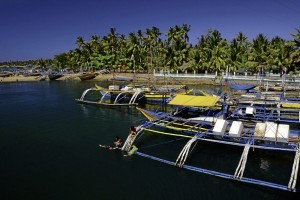
FISHING boats of various sizes are docked in a sandy area at the mouth of the Balingasay River in Bolinao, Pangasinan. WILLIE LOMIBAO / CONTRIBUTOR
BOLINAO, Pangasinan—Very June 1, Romeo Rulloda, a fisherman, pulls his single-engine, 16-horsepower wooden boat to a dry dock and hangs his fishing lines near his house in the coastal village of Balingasay in Bolinao, Pangasinan.
He has been doing this for a decade simply because he dreads going to the sea in June. “June is not a good month for me,” Rulloda, 41, says in Filipino. “I have had near-death experiences [in the sea] during that month.”
He was 18 years old when he was first stranded for two days in an area in the West Philippine Sea (South China Sea), some 30 nautical miles off San Fernando City in La Union, while fishing alone.
“It was June. I thought I would die. My engine conked out and there was a thunderstorm. I could see the lightning and strong waves were filling my boat with water. I just kept on removing the water from my boat and stayed in it,” Rulloda recalls.
Luckily for him, strong currents took his boat near the shore, enabling him to paddle to safety.
In June 2002, Rulloda would go through that experience again, prompting him to promise to himself that he won’t ever go to the sea again in June.
“Actually, almost every Bolinao fisherman has a story to tell,” says Pangasinan Rep. Jesus Celeste, who was a fisherman, and later a fish dealer and boat owner, before joining politics in the late 1990s.
And in any month, he says, accidents happen in the open sea. He says he experienced clinging to his capsized boat for six hours after it was battered by strong waves in the late 1980s.
“That is why I was not surprised when a foreign vessel rammed a Bolinao fishing boat on June 20. To us here, that was a normal incident because there have been several similar incidents in the past, especially at night,” Celeste says.
One fisherman was killed in the accident and four others are missing. Three survived to tell their stories.
Fred Castelo, Bolinao administrator, says the most dangerous period for deep-sea fishing is from November to February. “This is because of monsoon winds. There’s no typhoon signal but all of a sudden strong winds blow, whipping up huge waves,” he says.
In December 2006, some 90 fishermen from neighboring Infanta town encountered this. Many of them were rescued days later at the disputed Panatag (Scarborough) Shoal.
Castelo says fishermen who often meet accidents at sea are those who are into deep-sea fishing, or those who fish beyond the 15-kilometer municipal waters.
At least 60 percent of Bolinao’s population of 69,568 (2007) depend on fishing. But only about 1,500 people are engaged in deep-sea fishing.
Deep-sea fishermen sail from six to 12 hours to payaw (artificial reefs) located 40 to 100 nautical miles (nm) from the shoreline.
The payaw, which are made up of small bamboo rafts where palm leaves are hung, attract small fish that feed on the planktons that settle on the fronds. Bigger fish, like tuna, are in turn attracted by the small fish.
Celeste says once in the payaw, fishermen would throw at least a hundred fishing hooks and lines into the water and pull them once fish bite them.
The prized catch for these fishermen in the deeper parts of the West Philippine Sea, Castelo says, is the yellow-fin tuna, which is abundant in the area.
Aside from tuna, fishermen also catch “galunggong” (round scad), blue marlin, and sometimes, “tanguingue” (Spanish mackerel) and “dorado” (dolphin fish).
Rulloda says on a good day, he makes P6,000. But he says there were also days when his catch was only worth P1,000, barely enough for his expenses for gasoline, food and water.